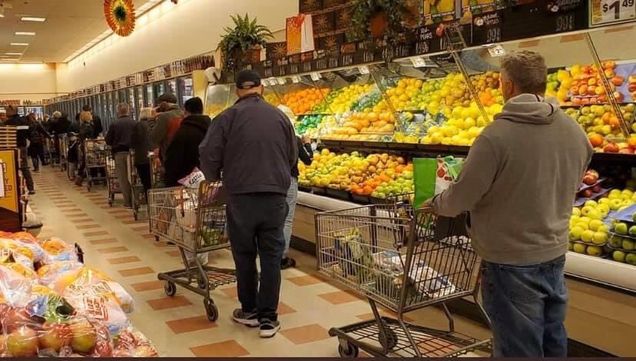Shopping for a Pandemic
Students in Karen Metheny’s Anthropology of Food (MET ML641) class are contributing posts this month. Today’s post is by David Ginivisian.

The rapid spread of Covid-19 and the resulting human response is cause for the end of the world as we knew it. Without being alarmist, my point is this: this pandemic will represent a crossroads in history, dividing how the world was before the outbreak and how the world will reconfigure in the years that follow. Both individual and collective reactions to this crisis will have far-reaching consequences causing sweeping changes in our ways of life.
Coronavirus first began to impact my lifestyle March 12. The school system in which I teach High School Culinary Arts had been ordered shut down for two days for ‘deep cleaning’. This was the beginning of an evolving response to the growing concern. These bonus days off allowed me to catch up on errands while my wife and daughter were working and attending their respective schools. It was quickly evident that my routine trip to the grocery store would be anything but.
It was Wednesday morning and the store was unusually full with customers. Upon entering, mindful customers lined up for what was now an obligatory sanitizing wipe for their cart and hands. Some shoppers donned gloves to avoid direct contact with potential germs. Foreshadowing the weeks to come, the high volume of customers crowded the aisles with overflowing shopping carts. While large crowds shopping with fervor are nothing new to those who frequent Market Basket, on this day the scene was strangely different.
The growing volume of shoppers was not dissimilar to a pre-blizzard shopping frenzy; still, something was awry. People were not moving about the store as they normally did. The flow was out of step with the usual pattern of cart traffic. Concerned store goers were showing signs of panic evident in their altered regular habits. Shoppers were abandoning their usual routes and routines. Haphazard movements caused traffic jams at every corner. Customers leaving carts to grab-n-go created a jaywalking effect on the line of traffic. Impromptu U-turns, backtracking, and exploring unfamiliar aisles all contributed to the slowdowns.
The Salem, MA store was populated with the usual diverse clientele, all with a shared objective: to stockpile necessities and niceties for an extended time. Some shopped in tandem, enlisting a divide and conquer approach of grabbing goods for one or two carts. Darting through the traffic, they would occasionally rendezvous to plan their next move. One of the ‘Dads’ (eyes glazed like a deer in the headlights), appeared to have been dispatched to run ‘Mom’s’ errand only to find himself engulfed in the fray. Senior citizens moved cautiously, pulling over to let the faster carts by. Some parents, with a sudden need to shop for breakfast, lunch, and dinner, were stocking up. Others had to bulk up home inventory for the anticipated arrival of college students’ unexpected homecoming. Usual shopping strategies interrupted and abandoned became the norm, instead navigating as quickly as the congested aisles would allow.
As one would now realize, the sanitizing products aisle had long been cleaned out. Most goods had been seemingly well stocked, but the relentless wave of shoppers would ultimately pick the shelves bare. The checkout line began to wrap around the store. The logjam left many in line for over one hour. I’m pleased to report that while there appeared to be mayhem, there was no malice. Fellow consumers collectively recognized that this was unchartered territory – extraordinary circumstances – and everyone was in the same boat. Examples of these shopping frenzies quickly posted to all media. Was it hoarding or simply stockpiling resources as a precaution? Some have described these behaviors as irrational, unethical, inappropriate, even shameful. Was it socially irresponsible to take more than one’s “fair share?” Who is to say?
The food industry, in particular, is suffering on all counts. Distribution systems have been compromised. Restaurants are either closed or struggling to remain viable, offering takeout, curb-side pickup, and delivery. Alarmed consumers now rely more than ever on the local supermarkets for provisions. The stores, in turn, are working tirelessly to stem the tide of overwhelming demand while addressing mounting concerns about how to keep all food and people safe.